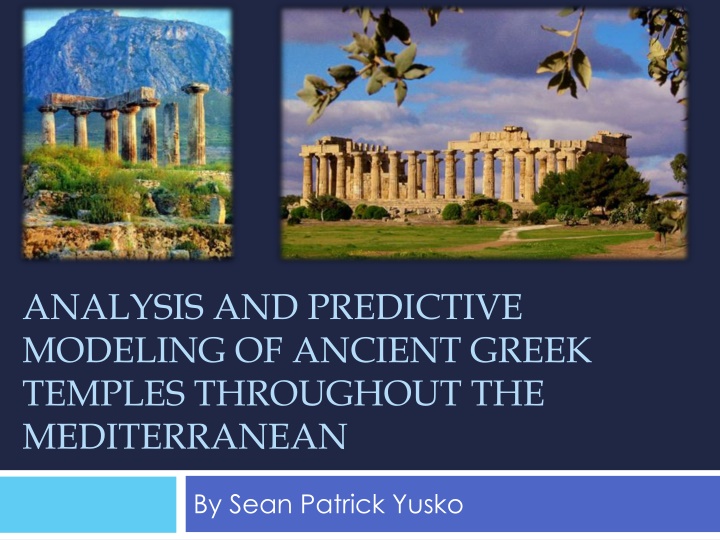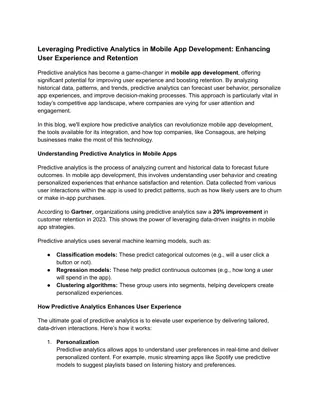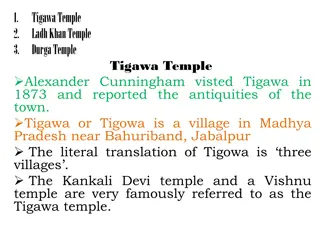Analysis and Predictive Modeling of Ancient Greek Temples Throughout the Mediterranean
This study by Sean Patrick Yusko delves into the analysis and predictive modeling of ancient Greek temples in the Mediterranean region. It focuses on spatial relationships, patterns, and potential predictive modeling based on data collected from 236 temples spanning from 800 BC to 150 AD. The research aims to bridge the gap in understanding sacred spaces, investigate spatial patterns, and identify relationships between temples and their surroundings. Methodologies include data collection, zonal statistics, autocorrelation analysis, and examination of temple relationships with physical features, deities, and architectural styles.
Download Presentation

Please find below an Image/Link to download the presentation.
The content on the website is provided AS IS for your information and personal use only. It may not be sold, licensed, or shared on other websites without obtaining consent from the author.If you encounter any issues during the download, it is possible that the publisher has removed the file from their server.
You are allowed to download the files provided on this website for personal or commercial use, subject to the condition that they are used lawfully. All files are the property of their respective owners.
The content on the website is provided AS IS for your information and personal use only. It may not be sold, licensed, or shared on other websites without obtaining consent from the author.
E N D
Presentation Transcript
ANALYSIS AND PREDICTIVE MODELING OF ANCIENT GREEK TEMPLES THROUGHOUT THE MEDITERRANEAN By Sean Patrick Yusko
Overview Classical Archaeology emphasis on individual site studies New interest in sacred space GIS analysis encompassing all temples Spatial relationships & patterns Predictive modeling
Introduction Temples carried cultural significance 236 temples from roughly 800 BC 150 AD
Statement of Problem A gap exists in on-going research concerning sacred space Little geographic data pertaining to temples No assessment of spatial patterns
Purpose Identify spatial relationships of temples with their surroundings and with each other Investigate those relationships
Potential Patterns DEITY COUNT MEAN STANDARD DEVIATION MIN MAX Apollo 35 166.82899 230.10899 2 1127 Unknown 34 152 280.93201 2 1522 Athena 29 139.517 180.41299 3 674 Zeus 18 258.77802 297.85699 8 995 Hera 17 40.647099 77.103401 -1 331 Artemis 17 225.52901 395.383 4 1482 Poseidon 7 29.7143 19.0467 5 54 Herakles 4 117.25 50.765999 65 197 Dionysos 4 33.75 38.284302 9 100 Demeter 4 140 154.47501 13 399 Aphrodite 4 418 259.479 60 766
Review of Literature Classical Archaeology Sacred space Temple surveys Greek city planning Roles of regional sanctuaries Rise of the polis Ancient tourism (Pausanias)
Methodology Research Data collection, creation (digitizing) Zonal statistics, autocorrelation Investigate relationships of temples with elevation, ecological data, water source Hill shade, temple orientation Investigate patterns with deities, architectural styles
Methodology cont. Are there meaningful geographic patterns with respect to physical features? Analysis and interpretation Data limitations Predictive modeling
Significance Aim to establish certain spatial correlations Investigate deity worship patterns Provide new data for exploration Use variables to predict temple locations
Plan of Work 4 weeks research, investigation, reading 2 weeks GIS operations 2 weeks analysis 2 weeks document and predictive modeling 2 weeks write final report























